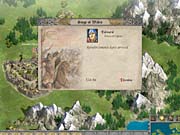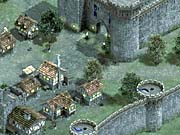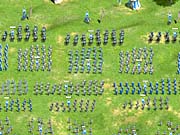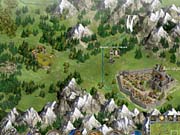Knights of Honor Impressions
We get a first look at Sunflowers Interactive's upcoming real-time strategy game.
We were recently visited by representatives from Sunflowers Interactive, who showed off their upcoming real-time strategy game, Knights of Honor. Developed by Black Sea Studios in Bulgaria, the game seems to resemble Age of Empires and other medieval-era strategy games, but, delving just a little bit deeper, we began to see that the similarities are largely superficial, thanks to the game's broader scope. According to Sunflowers, Knights of Honor won't be a conventional real-time strategy game so much as it will be an "empire-conquering simulation."

The goal of Knights of Honor is to rule all of medieval Europe using such strategies as war, diplomacy, and espionage. The game's world map encompasses just about all of Europe, from Portugal in the west, to Norway and Sweden in the north, and over to the westernmost fringes of Russia to the east. What's interesting is that everything in the game happens seamlessly in real time. At one moment you might find yourself in the world view map, issuing global orders to your various provinces, or "realms" as they're called in the game, while in the next moment you may find yourself zooming in to get a tactical level view of the map to examine your realms in more detail or to closely manage battles as they happen.
Sunflowers was careful to note that Knights of Honor's focus is on global strategic decisions as opposed to low-level management. You're supposed to take the role of a king, after all, and kings do not worry about the placement of every last farm or dock in their lands. As such, you're able to obtain the services of knights to help manage each of your realms and armies. Each of the game's 1,000 unique knights has a handful of special attributes to differentiate them from one another. One example of these special attributes is "dread." Any army led into the field by a knight with the dread attribute strikes fear into the enemy and imparts morale penalties. The "leadership" trait allows a knight to march an army across the land faster than normal. Other abilities may impart economic bonuses on the realm governed by a particular knight.
Though the knights handle the low-level economic decisions, you're still able to dictate the production priorities of your various realms. From the game's close viewpoint, you'll see woodlands, farms, and mines surrounding the central castle. If you shift production focus to food, additional grain icons pop up over the farms, whereas focusing on stone mining reveals more brick icons over the tops of the mountainous areas. These little visual cues are reminiscent of city management in Civilization.
The game's resources are divided into three categories: basic, valuable, and exotic. The basics include food, wood, stone, and metal, all of which can be harvested from your lands. Valuables can be plundered from captured territories, while exotics require you to build an advanced harbor or capture a territory that contains one; this allows for trade with the Far East.

Aside from economics, you also manage the advancement of castles, which serve as the center of your realms. They all start off as small wooden stockades, and, as you spend resources to upgrade them, they grow in size and eventually become impressive stone edifices, complete with walls, towers, and internal keeps. Upgrading the castle also opens up additional tech upgrades; you can purchase siege factories, markets, and/or other buildings to increase the functionality of the castle. You can also add battlements and other defensive emplacements. From the close view mode, you can see a lot of visual detail in and around your castles. Peasants scurry about doing their daily work, while archers and other soldiers man the walls and keep watch from defensive emplacements.
The level of activity you see in and around your castles is one of the aspects affected by the game's day-night cycle. Superficially, the game changes in appearance. You see your castles and towns lit by torchlight as darkness falls over the land. On a more practical level, the darkness cuts down on the line of sight of your enemies, so moving armies and fighting battles under the cover of night creates some new wrinkles in gameplay. At this early stage of development, Black Sea hasn't yet decided how to balance the length of the day-night cycle or even the ratio of daylight to nighttime hours.
Divide and Conquer
Diplomacy also plays a pivotal role in Knights of Honor. With 150 different realms and several different factions to deal with, it's unlikely that anyone can gain them all through sheer conquest. Using the diplomacy features, you're able to interact with your AI opponents to create alliances and peace treaties, or you can declare war. The interface and choices in the final game let you pull off some fairly complex schemes. For instance, you can marry off your daughter to another king and then send an assassin over to kill that king, thus gaining all of his lands by right of the marriage--in a manner similar to the politicking of Medieval: Total War. Of course, getting caught in such a treacherous play will not endear you to the other leaders.

Diplomacy or not, no medieval strategy game would be complete without battles. Should you choose to manually control your troops in battle, instead of letting one of your knights take care of things, you're able to control more than 30 different kinds of units, such as archers, mounted cavalry, and various siege engines, like catapults, trebuchets, siege towers, and ladders. The various regions of Europe supply unique units that you can field in battle. If you own a piece of England, you're able to recruit their famous longbowmen. Owning a province in Germany gives you access to the powerful Teutonic champion units.
As with most games of this type, unit control is done at the company level, so you'll see your men moving in formation and acting in groups as they respond to your orders. Besieged castles and other buildings display several levels of destruction to give you quick visual cues as to the progress of your siege. Once you break through the outer walls, your men can set fire to the wooden structures inside and burn them to the ground as you make your way to the central keep. Defenders can fire at you while stationed on top of walls and battlements, and stationary castle defenses may also thwart your advance.
The game also includes a handful of historical campaigns that emphasize battles. Some real battles from history, like the Battle of Hastings, have been re-created in the various scenarios. The game's multiplayer modes also focus on the battle aspects of the game. Up to six players can be supported online or over a LAN.

We can already see a good level of polish in Knights of Honor's graphics. It's shaping up to be a very attractive-looking game with clean artwork and detailed structures. Castles and towns appear very lifelike, and peasants bustle around while smoke wafts up from fires and chimneys. Even the scale of people to buildings is done quite well. Soldiers walking atop castle walls and peasants working next to huts or wandering through markets all look very natural and don't appear to be over- or undersized relative to the buildings. The terrain features also look great, with rivers winding through the land, mountains rising up out of the ground, and hills rolling with lush greenery. Since the game map is a true representation of Europe, you can also expect important terrain features to be where you'd expect them to be, including the Alps and all the major rivers. The trade-off for all of this detail is that the engine is 2D, so no zooming or rotation is possible.
Although medieval-era strategy games are not exactly in short supply for the PC, Knights of Honor has a unique style and promises some interesting features that may help it to gain some valuable attention in this crowded market. The game is scheduled to ship in the second quarter of 2004.
Got a news tip or want to contact us directly? Email news@gamespot.com
Join the conversation